Light Touch: an exhibition of exquisite photographs of butterflies and moths
Light Touch is an exhibition of exquisite photographs of butterflies and moths from the Museum’s collection by Katherine Child. It is no longer on display in the Museum but please browse the images below.
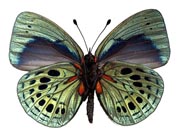
Antigonis felderi, Bates 1864
From the Nymphalidae, the largest family of butterflies, which are often brightly coloured, although some species have a duller underwing.

Sarosa xanthobasis, Druce 1898
A member of the Arctiinae subfamily of moths. In North American folklore it is believed that the worse the coming weather, the darker the black markings on the larva of certain species of Arctiinae.
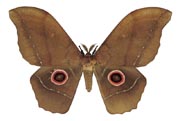
Imbrasia eblis, Strecker 1836
This Saturniid moth’s spots are a form of natural mimicry, evolved to resemble
the eyes of another creature to scare or deflect predators. These spots allow the
moth to look like the face of an owl.

Eusemia conferta, Walker 1865
This specimen was collected in 1864 by Alfred Russel Wallace, a prominent
British naturalist, explorer and biologist who conceived - independently of Charles Darwin - the idea of evolution through natural selection.
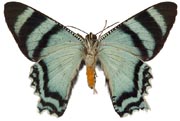
Lyssa boops (Westwood 1879)
Collected by Alfred Russel Wallace, this specimen was used by the first Hope
Professor at Oxford University Museum of Natural History, John Obadiah Westwood, to describe the species.
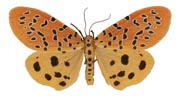
Argina pulchra, Swinhoe 1892
This brightly coloured male is from the Arctiinae subfamily of moths, but
others are comparatively dull. Colonel Charles Swinhoe, who described this species, spent many years arranging, cataloguing and describing exotic moths from the Museum’s collections.
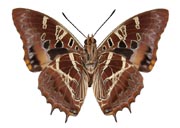
Charaxes eudoxus kateræl, Carpenter 1937
Part of the family Nymphalidae, one of the largest in the Lepidoptera order of moths and butterflies. This specimen was used by Geoffrey Hale Carpenter to describe the species.
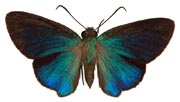
Coleliades immaculata, Carpenter 1935
This brilliant blue skipper butterfly was collected along the Alanga River in Ethiopia. It is a type specimen described by Geoffrey HaleCarpenter, who studied African Lepidoptera obsessively, investigating how bird predators shaped butterfly mimicry patterns.
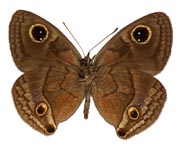
Calisto anegadensis
Smith, Miller & McKenzie 1991
A Satyr butterfly endemic to the British Virgin Islands. This specimen was collected
by David Spencer Smith. The Museum collections contain several cabinets of
Neotropical specimens collected by Spencer Smith, many of which include species
endemic to different Caribbean islands.
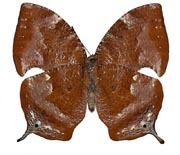
Anaea kingi, Miller & Nicolay 1971
Butterflies from the genus Anaea are called ‘tropical leafwings’ because the undersides of their wings resemble dried leaves, as you can see. This male was collected in 1970 from Cerro Campana, Panama by H. L. King.
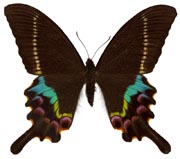
Papilio krishna, Moore 1857
This swallowtail butterfly was collected in 1913 in Kabru, Manipur, India by Major General Sir H. C. Tytler. The Hope Entomological Collections contain more than a thousand butterflies collected by Tytler, mainly from Burma and India.
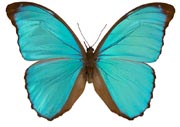
Morpho menelaus, Le Moult 1925
This Morpho butterfly was described by Eugène Le Moult, who collected it in the Orinoco Delta in Venezuela in 1925. Le Moult’s two volume Les Morpho d’Amérique du Sud et Centrale, Paris 1962-1963 is considered to be one of the most important works on the Morphinae subfamily.
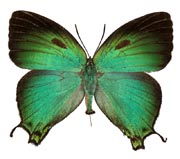
Arcas gozmanyi, Balint 2006
This species comes in many variations, with colours ranging from golden to blue to the metallic green seen here. This is a type specimen from the Lycaenidae family, many of which have symbiotic relationships with ants. In some species the larvae are protected by ants which in turn feed on the caterpillars’ honeydew.
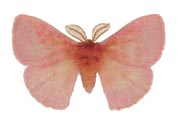
Decachorda rosea, Aurivillius 1898
A Rose Silk Moth from the family Saturniidae, which includes some of the world’s largest moths. Although Saturniids are not related to true silk moths, the caterpillars of most species spin silken cocoons which are still gathered by people to make silk fabric.
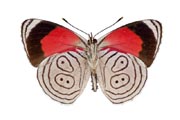
Diaethria phlogea (Salvin & Godman 1868)
Named the 89/98 butterfly due to the characteristic pattern on the underside of the
hind wing. It is a common feature within the genus Diaethria to have black dots surrounded by concentric black and white lines.
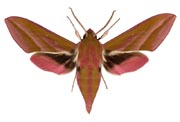
Deilephila elpenor (Linnaeus 1746)
This strikingly-coloured Elephant Hawk-moth has a wide distribution throughout Europe and Asia. The larva of this species has a long trunk-shaped anterior (front), and it is this ‘trunk’ which gives the moth its name, rather than its size.
